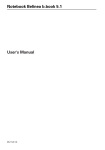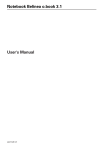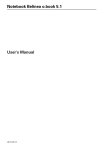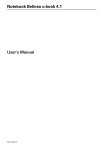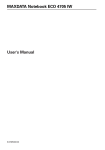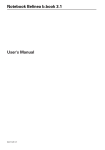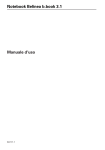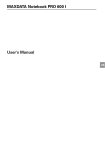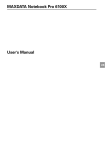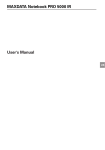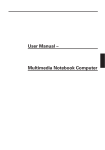Download MAXDATA Multimedia Notebook Computer User guide
Transcript
User Guide Multimedia Notebook Computer 45 46 Contents NOTE ...................................................................................................... 49 IMPORTANT SAFETY INFORMATION .................................................. 52 Wireless LAN ................................................................................................ 54 Additional safety notes for units with wireless LAN ...................................... 55 CE-labelling for units with wireless LAN ....................................................... 56 Restrictions ................................................................................................... 57 Radio frequencies for units with wireless LAN .............................................. 58 Frequencies .............................................................................................. 58 Legal requirements - exception clauses for units with Wireless LAN ............ 59 SHIPPING CONTENTS .......................................................................... 60 PREPARATION ....................................................................................... 61 INSERTING THE BATTERY ............................................................................ 62 REMOVING THE BATTERY ............................................................................ 62 POWER SUPPLY ........................................................................................... 63 Switching the Computer On .......................................................................... 64 Powermanagement ....................................................................................... 65 SYSTEM OVERVIEW .............................................................................. 66 LEFT AND RIGHT SIDES ............................................................................... 66 REAR VIEW .................................................................................................. 67 UNDERSIDE .................................................................................................. 67 EXPLANATION OF LED DISPLAYS ................................................................ 68 Hot Keys ....................................................................................................... 69 The Quick Launch KEYS ................................................................................ 70 The Keyboard ................................................................................................ 71 The TouchPad ................................................................................................ 72 The CD-ROM/DVD DRIVE ............................................................................. 73 Volume .....................................................................................................74 The PC - CARD Slot ...................................................................................... 75 The Memory Stick/ SD/ MMC -Slot ............................................................... 75 The DATA / Fax Modem ................................................................................ 76 The LAN-Port ................................................................................................. 76 INSTALLATION INSTRUCTIONS ........................................................... 77 Restoring the drivers ..................................................................................... 77 Utility CD ...................................................................................................... 77 Setting the Resolution .............................................................................. 78 SPECIFICATIONS ................................................................................... 79 FAULT DIAGNOSIS AND TROUBLESHOOTING ................................... 83 47 48 NOTE The company reserves the right to make unadvertised modifications to this document. Information contained in this document is intended solely for reference purposes and in no way constitutes a basis for asserting obligations on the part of the manufacturer or vendor. Neither the manufacturer nor the vendor accept liability for any errors or inaccuracies that this document may contain. Nor is liability accepted for damages or losses that arise from the incorrect application of this guide. No part of this document and the accompanying software may be copied, translated, or distributed without the prior permission of the dealer, manufacturer, or authors. Archive copies for private use are excepted from this rule. Brand or product names mentioned in this document may be names protected by copyright law or registered trademarks of other companies. These are mentioned only for identification purposes and have no recommendatory character in respect of the product or manufacturer. © MAXDATA 2004 Legal Information You can find additional legal information and conditions in the text files on the device drivers and utilities CD-ROM (Utility CD). Acrobat and the Acrobat logo are trademarks of Adobe Systems Incorporated or its subsidiaries. In certain jurisdictions these trademarks may be registered. Intel and Pentium are registered trademarks of Intel Corporation. MS-DOS, Windows, Windows 95, Windows 98, Windows Me, Windows 2000, Windows XP, and Windows NT are registered trademarks of Microsoft. Application & References This user guide offers an introduction and is intended to provide instructions for your first steps with your new computer. If you wish to use an operating system that is not mentioned in these documents, consult the ReadMe files on the CD-ROM for the relevant information. Please also consult your dealer to make sure that it is possible to run your chosen operating system on your notebook. The operating system is not contained on the device drivers and utilities CD-ROM. 49 Note: Some or all system configurations may have been made already. If this is not the case or if parts of the system need to be reconfigured, please consult the device drivers and utilities CD-ROM for instructions on how to do this. Declaration: This device meets the EN 55022 product standard for interference emissions, the EN 50082-1 basic standard for interference, and the EN 60950 low voltage directive standard. If any modification that has not been agreed with the manufacturer is made to the device, adherence to these standards can no longer be guaranteed. To ensure electromagnetic compatibility (EMC), please observe the information given in the handbook. Sound Power Level The workplace-based sound power level is less than 55 dB A. Federal Communications Commission (FCC) Note This device has been tested and found to comply with the limits for a Class B digital device, pursuant to Part 15 of the FCC Rules. Operator Note: This device has been carefully RF suppressed and tested to avoid radio interference. However, please pay attention to the following concerning external data cables: If it becomes necessary to replace a data cable specified by the manufacturer, then for correct radio interference suppression the operator must ensure that replacement cables match the original cable also as pertains to screening quality. Use only screened cables and external devices that are identical with this product in safety level and EMC behavior. In case of non-observance, compliance with the standards mentioned above is no longer guaranteed! 50 CD-ROM Drive: The built-in CD-ROM drive is a Class 1 laser product. Do not open the device and do not look into the beam, not even with optical instruments. Unless the drive is expressly designated for the simultaneous use of more than one CD, never insert more than one CD into the drive. Returning the Device We offer a return guarantee: We use materials that allow professional reprocessing or disposal. This means that your notebook is fully recyclable. The outside packaging and all inner parts of the box can be disposed of as waste paper. 51 Safety Information IMPORTANT SAFETY INFORMATION Although the notebook is highly robust, it is not indestructible. To prevent damage from occurring, please pay attention to the following: • Avoid exposing the notebook to strong shocks or vibrations. • Keep it away from intense heat (radiators, direct sunlight). • Protect the notebook from electromagnetic interference. This will also prevent data loss. • Do not expose it to moisture. This is an electrical device! • Be sure to use the correct power supply. Always use an approved power adapter. The power adapter requires a fluctuation-free and uninterrupted power supply. If you have any questions, consult your local electricity supply company. The power adapter must be fitted with a grounded (earthed) plug. Never pull the cable to unplug the power supply – always pull the plug itself. Disconnect the external power supply (power adapter or car adapter) before cleaning the computer. • Notes on Using Batteries Only ever use batteries designed for use with this computer. Recharge batteries via the notebook. Do not attempt to repair faulty batteries yourself. Entrust repairs to your dealer or qualified service personnel. Keep damaged batteries away from children and dispose of them properly as soon as possible. Exercise caution in handling damaged batteries. Batteries may explode if exposed to fire or improperly handled or disposed of. The notebook is provided with a battery. The battery is recyclable. It is prohibited by law to dispose of the battery in ordinary household waste. If you have questions concerning proper disposal, consult your garbage collection service. 52 Safety Information • Note on the System Clock Battery Caution: There is a risk of explosion if batteries are installed incorrectly. Replace the battery only with a battery recommended by the manufacturer or with a battery of the same type. Dispose of the battery according to the manufacturer’s instructions. • Servicing Do Not Service Your Computer Yourself! You could invalidate your warranty rights and expose yourself and the device to the risk of electrical shock. If servicing is required, consult qualified service personnel. Disconnect the computer from the power supply. If the following problems occur, consult qualified service personnel: - Power adapter or power cable is damaged or frayed. - Liquid has entered the computer. - Despite operating it correctly, the computer is not functioning properly. - The computer has been dropped or damaged. • Cleaning Never apply cleaning agents directly to the computer. Use only a soft, lintfree cloth. Never use volatile (petroleum distillates) or scouring cleaning agents. 53 WIRELESS LAN (wireless network- abbreviation = WLAN) Your Notebook contains a Wireless LAN module of the type „Intel® Pro Wireless Mini PCI“. This module allows you to set up a wireless-based network, and to connect with an existing wireless network. It works according to the IEEE802.11b+g standard. WLAN technology allows users to set up wireless connections inside a local area (e.g. in a company or campus building, or in a public building such as an airport). WLANs can be used in temporary offices, in locations where it is not possible to set up extensive cable installations, or to extend an existing LAN so that users in different parts of a building can work at different times. There are two different ways to operate a WLAN. In fixed WLANs, wireless stations (devices with radio network cards or external modems) set up connections with wireless access points, which act as bridges between the stations and the existing network backbone. In Peer-to-Peer (ad hoc) WLANs several users can set up a temporary network within a limited area such as a conference room, without using access points, and providing there is no need to use network resources. In 1997 the IEEE confirmed the standard 802.11 for WLANs; this set a data transfer rate of from 1 to 2 Mbit/s (Megabits per second). With 802.11b+g, the new governing standard, the maximum data transfer rate is 54 Mbit/s over a frequency band of 2.4 GHz (Gigahertz). 54 ADDITIONAL SAFETY NOTES FOR UNITS WITH WIRELESS LAN A wireless LAN component is integrated into your Notebook. For this reason you must make sure that you comply with the following notes on safety: • Switch off the Notebook when you are in an aircraft or while driving a car. • If you are in a hospital, an operating room or close to an electronic medical system, switch off the wireless components in the Notebook! The radio waves which are transmitted could disrupt the working of the medical equipment. • Keep the Notebook at least 20 cm away from a heart pacemaker, otherwise there is a risk that the radio waves could disrupt the normal working of the pacemaker. • The radio waves which are transmitted could give rise to interference noise in hearing aids. • When its radio components are switched on, do not place the Notebook close to inflammable gases or in an environment which could be at risk of explosion (e.g. paint shop), since the radio waves which are trans mitted could set of a fire or an explosion. • The range of the wireless connection depends on the environmental and other ambient conditions. • When transferring data over a wireless connection, unauthorized Third Parties can also receive the data. 55 MAXDATA Computer AG is not responsible for disruptions to radio or television reception which are caused by unauthorized alterations to this unit. MAXDATA also accepts no responsibility for the replacement or the exchange of connecting cables and units which were not specified by MAXDATA Computer AG. The user alone is responsible for the elimination of disruptions caused by this type of unauthorized alteration; he is also responsible for the replacement or the exchange of the units. CE-LABELLING FOR UNITS WITH WIRELESS LAN As delivered, this device complies with the requirements of the Guideline 1999/5/EG of the European Parliament and of the Council dated the 9. March 1999 concerning radio equipment and telecommunications facilities, and the mutual recognition of conformity. This Notebook may be used in Belgium, Denmark, Germany, Finland, France, Greece, Great Britain, Ireland, Italy, Luxembourg, the Netherlands, Austria, Portugal, Sweden, Switzerland, Spain, Iceland, Liechtenstein and Norway. Current information on any possible restrictions in its operation can be obtained from the appropriate authorities in each country. If your country is not included in the above list, then please contact the appropriate supervising authority, in order to check whether the use of this product is permitted in your country. Belgium - www.bipt.be, Denmark - www.tst.dk, Germany - www.regtp.de, Finland - www.ficora.fi, France - www.art-telecom.fr, Greece - www.eett.gr, England - www.oftel.gov.uk, Ireland - www.comreg.ie, Italy - www.agcom.it, Luxembourg - www.etat.lu/ILT, 56 Netherlands - www.opta.nl, Austria - www.rtr.at, Portugal - www.urt.gov.pt, Sweden - www.pts.se, Switzerland - www.bakom.ch, Spain - www.cmt.es, Iceland - www.pta.is, Liechtenstein - www.ak.li Norway - www.npt.no RESTRICTIONS • FRANCE Restricted frequency range: In France, you may only use channels 10 to 11 (2457 MHz or 2462 MHz). It is forbidden to use the unit outside of enclosed areas. Info: www.art-telecom.fr • ITALY An official authorization is also required to use the unit in internal areas. For more detailed information about the necessary procedure to do this, please contact your provider. It is forbidden to use the unit outside of enclosed areas. Info: www.agcom.it • NETHERLANDS A licence is required to use the unit in the open. For more detailed information about the procedure to be followed for this, please contact your provider. Info: www.opta.nl 57 RADIO FREQUENCIES FOR UNITS WITH WIRELESS LAN The following information was correct at January 2002. You can obtain current information from the appropriate authorities in your country (e. g. www.regtp.de). FREQUENCIES Radio network cards and adapters are designed in accordance with IEEE-Standard 802.11b+g for use in the ISM frequency band (Industrial, Scientific, Medical) between 2.4 and 2.4835 GHz. Because of the DSSSprocedure (Direct Sequence Spread Spectrum), each of the 11 usable radio channels takes up a width of 22 MHz; this means that up to three, independent channels are available (e.g. 3, 8 and 11). The following table lists the authorised channels in your country: Channel MHz Europe, R&TTE 1 2412 X 2 2417 X 3 2422 X 4 2427 X 5 2432 X 6 2437 X 7 2442 X 8 2447 X 9 2452 X 10 2457 X X 11 2462 X X 58 France, R&TTE LEGAL REQUIREMENTS - EXCEPTION CLAUSES FOR UNITS WITH WIRELESS LAN The installation and use of an unit with Wireless LAN may only take place when in accordance with the instructions contained in the user documents. The user documents are included in the material supplied with the product. All alterations or modifications made to this unit which are not expressly authorised by the manufacturer may lead to cancellation of the right of the user to operate the unit. The manufacturer is not liable for radio disruptions during the reception of radio and television signals which are due to non-authorised alterations to the unit or to the exchange or connection of cables and accessories, where these are not in accordance with the recommendations of the manufacturer. It is the responsibility of the user to remove any interference which may arise as a result of any non-authorised alterations, or the addition or replacement of components. Neither the manufacturer nor his authorised dealer and wholesaler are liable for damages or breaches of legal regulations which result from an infringement of these guidelines. 59 Shipping Contents SHIPPING CONTENTS Before you begin installing your notebook, make sure that all components are present. If any item listed in the shipping contents is missing from your computer package, please contact your dealer immediately. • Notebook • Battery • Utility CD • Power adapter • Power cable • User guide • CD- or DVD/DVD-RW- ROM or Combo- drive (built in) • Modem cable Please retain the original packaging in case you need to send the device for repairs or upgrades. Please store the packaging safely. 60 Preparation PREPARATION Before first using the computer, make sure you are familiar with the individual components of your system. Press the release catch (1) and open the display (2). (1) (2) Press release catch Open the display (1) (2) (3) (3) (4) (5) (6) (7) (8) (9) (10) LCD display Status LEDs CD player controls Power button Quick launch keys TouchPad Built-in microphone Keys and scroll pad Hand rest Keyboard Loudspeaker Fig. 1 Fig. 2 61 Preparation INSERTING THE BATTERY (The battery is included in the notebook’s shipping contents. This battery is only partially charged. Fig. 3 (1) (2) (3) Insert the battery into the battery slot in the direction of the arrow. Gently push the battery until it locks into place. Lock the battery into position. The battery can now be charged up. Make sure that you allow the battery to charge for TWO hours if the computer is switched off, or for FOUR hours if the computer is switched on! It is absolutely essential that the first time you charge the battery you fully charge it! Do not unplug the notebook from the power adapter until the battery is fully charged. REMOVING THE BATTERY Slide the catches (3) backwards. The battery is released. Slide the battery out of the holder and lift it upwards out of the battery slot. You can now run the notebook with the power adapter alone! 62 Preparation POWER SUPPLY You can choose to run the notebook via battery or power supply. The first time you use the computer, you need to use the power adapter. Use only the supplied power adapter. Using the wrong power adapter can cause damage to the computer. The notebook is supplied with a power cable and a universal, self-adjusting power adapter. The power adapter can operate with any constant voltage between 100 and 240 volts. To use the power adapter: 1. Connect the power adapter to the DC IN socket on the computer. 2. Connect the power cable to the power adapter. 3. Connect the power cable to a power outlet. The power adapter contains no serviceable parts. NEVER OPEN THE POWER ADAPTER ! DANGER OF DEATH ! Fig. 4 63 Preparation SWITCHING THE COMPUTER ON You’ve completed the preparation. Now operate the on/off button to switch the notebook on. Once the computer is switched on, the on/off switch can perform several functions depending on the energy settings. In the standard settings, pressing it again will switch off the computer. Tip: Fig. 5 Note: Please note that with the Windows operating systems you should always switch off the computer as follows: Click the Start button Select Shut Down Click OK This avoids any problems with the hard disk and operating system. If you experience a program or system catch, press the buttons: Ctrl + Alt + Del. If you’re fortunate this will enable you to end only the task that has crashed and/or restart the computer. (Warm start). If this does not work, hold down the on/off button for more than four seconds – this will switch off the computer. You can now start up the computer as normal (cold start). The operating system is installed the first time you switch on the computer. Please follow the operating system’s installation instructions here. After installation and restarting, the computer is ready to use. The basic graphics functions allow you to modify the resolution, color depth, and desktop appearance. You can find more detailed information on this point in the installation instructions. 64 Powermanagement POWERMANAGEMENT Your system is compatible with APM and the newer (and more efficient) ACPI energy saving system. Note on PC Cards Never unplug a PC card while the system is in save-to-disk mode. This would deactivate the slot and problems could occur with a modified system configuration the next time you start up the computer HARDWARE (Battery Status & Warnings) After completing the POST (power-on self-test), the battery status display shows the charge state of the battery. The symbol flashes when the battery charge is low. Save your data immediately and connect the power adapter. Low charge level & SUSPEND When the battery runs low (without the power adapter connected), one of these two protective functions is automatically activated: Without hibernate If there is no save-to-disk file or partition set up on your system, then current data will be stored in RAM and the system automatically switches into suspend mode. With hibernate Data is saved in the special file or partition on the hard disk reserved for this purpose. The computer then automatically switches off. If there is no save-to-disk file or partition available, the system switches into suspend mode. 65 System Overview SYSTEM OVERVIEW LEFT AND RIGHT SIDES Fig. 6 (1) (2) (3) (4) (5) Volume control Memory Stick, Secure Digital and MultiMedia card slot PC card slot PC card release catch Infrared sender/ receiver Fig. 7 (1) (2) Kensington lock - anti-theft device Ventilation opening All air intake and ventilation openings must be kept free from obstructions at all times. If not, the device is liable to overheat. 66 System Overview REAR VIEW Fig. 8 (1) (2) (3) (4) (5) (6) (7) (8) (9) (10) Power in socket S-Video TV output Connector for external monitor Printer port Modem port Network port IEEE 1394 port USB port Loudspeaker/ headphones socket supports S/PDIF output LINE IN / microphone socket UNDERSIDE * All air intake and ventilation openings must be kept free from obstructions at all times. If not, the device is liable to overheat. (1) RAM cover (2) Hard disk slot (3) Battery slot (4) Battery release (springloaded) (5) Battery release (with lock) Fig. 9 67 System Overview EXPLANATION OF LED DISPLAYS (1) Wireless LAN (2) Power (3) Standby (4) Drive access (5) Battery (6) Caps Lock (7) Num Lock Fig. 10 Symbol Meaning Lights when the wireless LAN properties are activated. Lights when the computer is switched on. Flashes when the battery reaches a low charge condition. Lights when the computer is in power saving mode Hard disk or CD-ROM drive is being accessed. Lights when the battery is charging. Lights when Caps Lock is on. Lights when Num Lock is on. Table 1 68 System Overview HOT KEYS (Shortcut key combinations with special functions) To activate the hot keys, press and hold down the Fn key and then press the desired additional key. For certain functions it may be necessary to install the Launch Manager. You can find additional information on this on the next page. Keys Meaning Fn + F1 Hot Key Help shows a list of hot keys Fn + F2 Switches to power saving mode Fn + F3 Switches between LCD / monitor / both Fn + F4 Switches the LCD to black to save energy Fn + F5 Switches the loudspeaker off / on Fn + PgUp Same operation as the Home key Fn + PgDn Same operation as the End key Fn + Increases LCD brightness Fn + Reduces LCD brightness Fn + F11 Switches Num Lock off / on Fn + F12 Switches Scroll Lock off / on Table 2 69 System Overview THE QUICK LAUNCH KEYS There are five quick launch keys on the left of the keyboard. You can use these to launch frequently used applications. If the keys are not assigned to any functions, you can find the drivers to activate the keys on the Utility CD. To do this, please follow the instructions in the “Installation Instructions” section. Fig. 11 (1) Wireless LAN - activates a wireless network (2) E-mail – starts the e-mail program (3) Internet – starts the Internet browser (4) Customizable – can be assigned to any application using the Launch Manager (5) Customizable – can be assigned to any application using the Launch Manager 70 System Overview THE KEYBOARD Your notebook’s keyboard has all the functions of a normal AT-compatible keyboard plus some extras: Typewriter Function keys - Special keys - These keys correspond to a typewriter’s keys. In many operating systems (and applications), special functions are available via these keys. You can find more detailed information on this in the relevant handbooks. These keys (and key combinations) are used for controlling various hardware functions. Press Fn + Num Lock to activate this field The LED lights up Fig. 12 Hot Keys: For the functions, see table 2 – Hot Keys Fig. 13 71 System Overview THE TOUCHPAD The system automatically sets up the integrated TouchPad. Provided you are using Windows, you do not need to install any drivers for the basic functions. If you wish to use the advanced functions, you can find the drivers to activate the keys on the Utility CD. To do this, please follow the instructions in the “Installation Instructions” section. You will find the following under the sensor field: (1) Left „mouse“ button (2) Scroll button – works like a mouse wheel (3) Right „mouse“ button Note for left-handers: Most operating systems enable reversal of the mouse buttons. Fig. 14 Left button Run Double-click Double-touch Select Single-click Single-touch Drag and Drop Click and hold down the button, then move the cursor to the position you want, using the pad. Let go. Double-touch, and on the 2nd touch keep your finger on the pad and move it to the position you want. Lift finger from pad Open short-cut menu Scroll 72 Right button Scroll button Sensor field Function Single-click Click at the top / bottom / right / left System Overview When using the TouchPad make sure your finger is clean and dry. The TouchPad reacts to finger movements. The lighter it is touched, the better it reacts. Pressing hard will not increase its accuracy. THE CD-ROM/DVD DRIVE To insert a CD, press the eject button on the front side of the drive. Fig. 15 Fig. 16 Place a CD onto the spindle with the label side facing up and push it gently down onto the spindle. Push the CD tray back in until it locks into place. The CD is now ready to read. Some CDs have an autostart function. This means that installation programs or music CDs automatically run after you place them in the drive. 73 SYSTEM OVERVIEW VOLUME (1) Volume down (2) Volume up Fig. 17 THE PC - CARD SLOT The computer is provided with a PC card slot. This is a PCMCIA 3.3 V/ 5 V slot, Type II. To insert a PC card, push it into the slot until it locks into place. Set the connection you require (e.g. network connection). You can also consult the documents for the relevant card. Fig. 18 To remove the card, push the eject button next to the slot. The button will pop outwards. Pressing the slot again releases the PC card. Fig. 19 74 SYSTEM OVERVIEW THE MEMORY STICK/ SD/ MMC -SLOT The computer is provided with a combination slot. This slot accepts Memory Sticks, SD (Secure Digital) and MMC (Multimedia card) cards. Insert these cards into the slot holding the printed side upwards. Once it has locked into position completely, you can access information on the card. To remove the card press it again. It will be unlocked. You can then remove the card from the slot. Never remove the card while data is being read from or written to the card! Fig. 20 If you cannot access the card, you can find the drivers to activate the cards on the Utility CD. To do this, please follow the instructions in the “Installation Instructions” section. 75 SYSTEM OVERVIEW THE DATA / FAX MODEM The system automatically sets up the integrated analog modem. To use the modem functions, connect the modem socket to an analog telephone socket (not ISDN) using the telephone cable. Proper Use: The modem can be connected to all analog sockets (TBR 21) in Europe. It is to be used solely for data communication purposes. Do not attempt to connect the modem to an ISDN telephone socket! This would result in serious damage to the device. Fig. 21 THE LAN-PORT The built-in network adapter enables your computer to connect to the Internet via a 10/100 Mbps network or DSL. The connection is made via an Ethernet network cable and RJ45 connectors. These are inserted on the back of the computer and into an available network hub or DSL socket. Under no circumstances should you confuse a network cable RJ45 connector with an ISDN connector! NEVER attempt to connect the LAN adapter to an ISDN telephone socket! This would result in serious damage to the device. 76 Fig.22 Software INSTALLATION INSTRUCTIONS RESTORING THE DRIVERS Your system is supplied in a preloaded condition. This means that all the data and drivers that the system requires are already on the hard disk. In case you erase and/or format your hard disk drive, the system drivers are stored on the Utility CD supplied with the computer. After reinstalling the operating system (for example, with the Recovery CD), this allows you to restore your notebook to a usable condition. THE UTILITY CD The Utility CD will run automatically after you place it in the drive. If this is not the case, you can run the CD as follows: select <My Computer”> <CD Drive> and then the “utility.exe” file. You can select the driver that you want to install in the “Drivers” -section. Recommended: All of the dri-vers listed from top to bottom. In addition, you can later install the advanced functions you require in the “Utility” section. When using the Utility CD, please follow the menu instructions. 77 Software SETTING THE RESOLUTION After installing the graphics drivers, set the resolution to 1024 x 768 pixels. You do this in the following way: Right-click on any free area of the desktop Select <Properties> In the Display Properties window, click the Settings tab. Here you can set the slider to 1024 x 768. Click <Apply> to set the resolution. 78 SPECIFICATIONS Appendix A Specifications Processor ● Intel® Centrino™ Mobile Technology - Intel® Pentium® M Processor 1.3 GHz to 2 GHz or - Intel® Celeron® M Processor to 1,7 GHz RAM • • Main memory expandable up to 1 GB DDR SDRAM Two PC2100 (DDR-266) soDIMM sockets Display and Video • • • • • 15.0 inch XGA TFT display. Supported resolution 1024 x 768 with up to 16.7 million colors Intel® 855 Graphics Controller - AGP 4X support Simultaneous LCD/external monitor External monitor: Supports up to 1280 x 1024, 16.7 million colors, 85 Hz or 1600 x 1200, 16.7 million colors, 60 Hz S-Video output Storage Capacity • • • One external USB floppy disk drive (3.5", 1.44 MB) (optionally available) One E-IDE hard disk drive (2.5", 9.5 mm) One internal CD- or DVD- or DVD-RW/ combo drive One Memory Stick / Secure Digital combo slot Audio • • • Sound Blaster Pro and Windows Sound System compatible Built-in loudspeaker and microphone LINE IN and LINE OUT (supports S/PDIF) 79 Appendix A - Specifications Modem • High-speed 56 Kbps V.90 fax/data software modem LAN • • Fast Ethernet for 10Base-T and 100Base-TX network standards 802.11b+g wireless LAN • • • 84/85/88-key Windows keyboard Ergonomically positioned TouchPad with scroll button Quick launch keys • • • • • • • • • • • • One 15-pin VGA connector One stereo output socket with S/PDIF One microphone input socket Infrared port (FIR) Three USB ports One standard telephone socket (RJ-11) One standard network port (RJ-45) One DC IN socket One S-Video OUT port One IEEE1394 i.Link port One Type II/I PC card slot One parallel port (ECP) printer port Input Devices Ports Power Supply • • • • • Main battery Li-Ion 65 W AC power adapter 100-240 V AV, 50-60 Hz, 70 W. Recharging System OFF: 2 hours (95%) System ON: 4 hours (95%) Battery power low warning Suspend/restore capability • O/S Microsoft Windows 2000 / XP Operating System 80 Appendix A - Specifications Other Data • • • • • Dimensions 270 (D) x 327 (W) x 29.8 (H) mm Weight 2.8 kg (depending on model) Operating temperature: 5 to 35°C Operating humidity: 20 to 80 % RH Storage temperature: -10 to 65 °C 81 Appendix A - Specifications 82 Appendix B - Troubleshooting FAULT DIAGNOSIS AND TROUBLESHOOTING If a problem occurs while working with your computer, first of all try using the following information to solve the problem. If the problem cannot be solved in this way, you can find additional information in the advanced service handbook (on the device drivers and utilities CDROM). If the problem persists, switch off the system for several minutes and then restart it. You will lose all unsaved data, but the system may work properly again. Subsequently contact your dealer or customer support agent. Although I’m pressing the power switch the computer stays switched off. Possible cause of the problem: The battery is missing or is incorrectly installed. Note: The power on LED is not lit. Troubleshooting: o Make sure that the battery is in the battery compartment and installed properly. o Check that the battery terminals are making direct contact. o Connect your notebook to the power adapter so that the battery (if present) can recharge. Possible cause of the problem: Battery level low. Note: The battery display LED flashes. Troubleshooting: Operate the computer using the power adapter. If the system does not immediately start up, switch off the computer and then restart it. 83 Appendix B - Troubleshooting The screen is not working. Possible cause of the problem: The energy saving mode is activated. Note: The suspend LED flashes. Troubleshooting: o Operate the on/off button. Possible cause of the problem: The screen settings are incorrect. Troubleshooting: o Press the spacebar, several times if necessary. o If an external monitor is connected, switch it on. Possible cause of the problem: In the system settings, a different screen type to the existing one is set. Troubleshooting: o Press the Fn + F3 key combination. o If an external monitor is connected, connect it to a power supply and switch it on. Also check the brightness and contrast settings (you can find additional information on this topic in the advanced service handbook). The system stops working. Possible cause of the problem: An energy saving function has been activated. Note: The screen switches itself off. Troubleshooting: Press any key, or press the on/off button if none of the status LEDs are lit. 84 Appendix B - Troubleshooting Possible cause of the problem: A software error has caused a system crash. Troubleshooting: o Additional information is available in the operating system handbook. o If you cannot remedy the problem, then restart the system. You will lose any unsaved data! If this doesn’t work either, briefly switch off the computer and then switch it back on again. Warnings Each time the system starts, it carries out a self-test (POST). If an error occurs, an error message appears, briefly describing the problem. 85










































